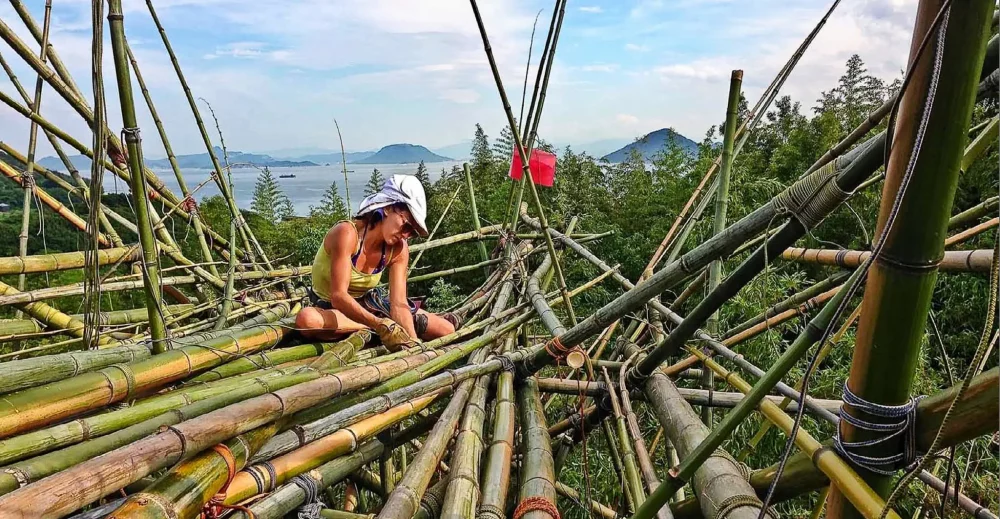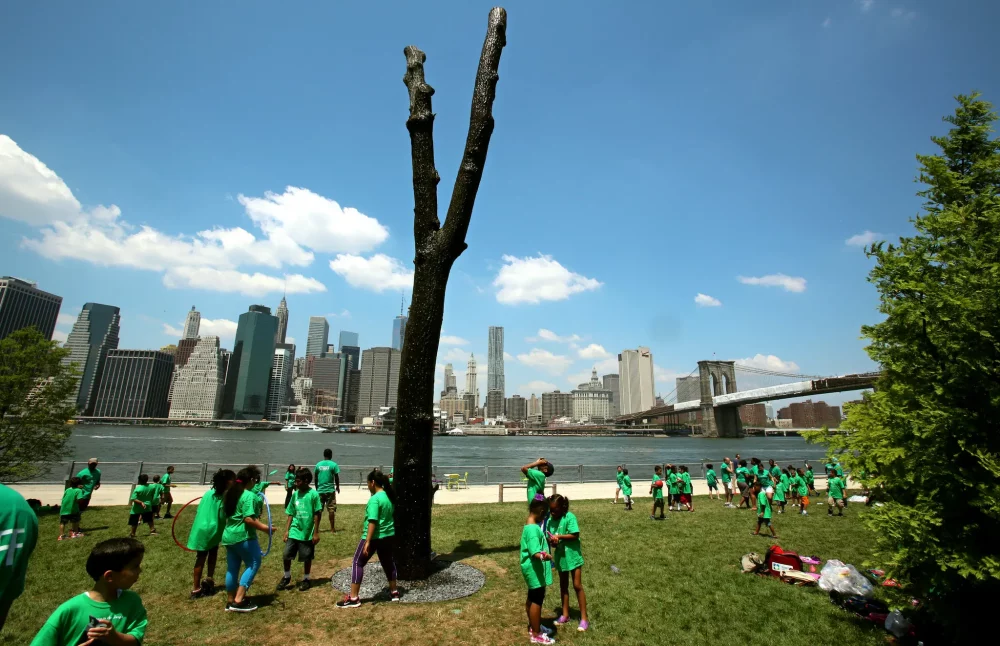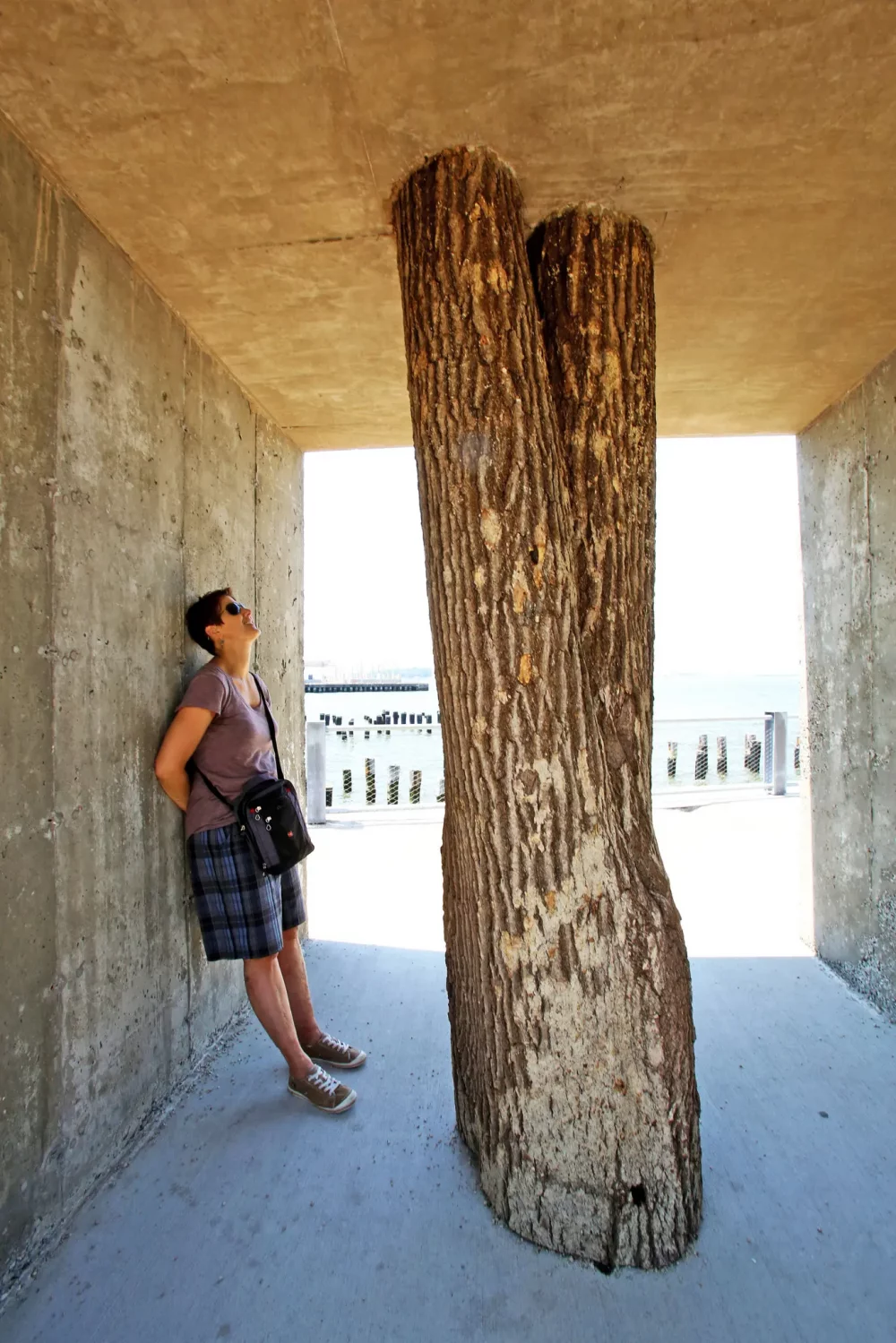
- Source: THE NEW YORK TIMES
- Author: ROBERTA SMITH
- Date: JULY 18, 2013
- Format: PRINT AND ONLINE
Ideally, Striving for an Organic Fusion

Doug and Mike Starn’s bamboo bridge on the Japanese island of Teshima.
These days you can find almost as much contemporary art outdoors as in. This is the legacy of Earthworks, also known as land art; site-specific open-air installations; and monumental sculptures. And then there’s plop art, transplanted from concrete plazas to green lawns, or onto something in between, like the gardenish median strips of Park Avenue, which are regularly dotted with large desultory objects. There are also those strange, gallery-like arrangements known as outdoor sculpture gardens, which rank high among my least favorite art viewing conditions (the Museum of Modern Art’s excepted).

Oscar Tuazon’s “People” in Brooklyn Bridge Park, in which denuded tree trunks are viewed against the skyline. Suzanne DeChillo/The New York Times
But today there is more and more art that can exist only outside because it is quite large or made of organic materials or, more interestingly, because it uses and even merges with the natural environment in a particular way. Sometimes it is the natural environment in largely unaltered form. For 2007’s Sculpture Projects Münster, an exhibition of outdoor works held every 10 years in Münster, Germany, the Polish artist Pawel Althamer blazed a narrow trail away from town that ended abruptly in a barley field, leaving viewers to fend for themselves. It was titled “Path.”
Art in natural settings often requires preparedness on the viewer’s part — sensible shoes, insect repellent, outerwear — as well as flexibility, a willingness to do a little hiking, climbing and, occasionally, bike riding. Bicycles were provided to visitors at the 2007 Münster exhibition and at documenta (13) in Kassel, Germany, last summer. Also useful are map-reading skills, as things can be hard to find. Perhaps the future will bring bikes equipped with fully programmed GPS screens.

Oscar Tauzon's "People" in Brooklyn Bridge Park. Suzanne DeChillo/The New York Times
Such art sometimes competes directly with nature, which may demand a rejiggering of aesthetic judgment. You have to be clear about what is affecting you; is it the art or is it just the great scenery? If the art seems to detract from, or depend too much on, the setting, there may be a problem. I would say that Mr. Althamer’s Münster piece was dependent to the point of invisibility, which has its own charm. Closer to home, the majestic entrance to Central Park at Fifth Avenue and 59th Street gains little from its current display, three large bronze figures by Thomas Schütte.
Other opportunities for assessment in New York this summer include “Red Yellow and Blue,” Orly Genger’s undulating mounds and barriers of brightly colored knitted rope in Madison Square Park, which form a landscape of their own. On the High Line, Carol Bove has inserted seven large-scale sculptures into the overgrown, as yet unrehabilitated northernmost portion of this great urban leftover. (Called “Caterpillar,” they are available for viewing only by appointment.) At Brooklyn Bridge Park on the East River, Oscar Tuazon’s “People” offers a semiabstract meditation on the never-ending competition between natural and urban: three hybrid installations that meld architectural elements in cast concrete and metal with tall, branchless tree trunks positioned to be viewed against the city’s skylines.
But the fusion of art and nature that I would most like to see is Doug and Mike Starn’s latest adventure in improvised bamboo sculpture. (Their “Big Bambú” was a popular rooftop exhibition at the Metropolitan Museum of Art in 2010.) The new work will have its debut on Saturday as part of the Setouchi Triennale on the Japanese island of Teshima. This extraordinary-sounding work is built of bamboo in, and atop, a bamboo forest. Cut bamboo elements tied to living trees form a 200-foot-long walkway that winds 60 feet upward to the forest’s canopy. It leads to a 60-foot boat, made of bamboo, floating on a windblown “sea” of bamboo leaves. It could be the ultimate in the art of becoming one with nature.

